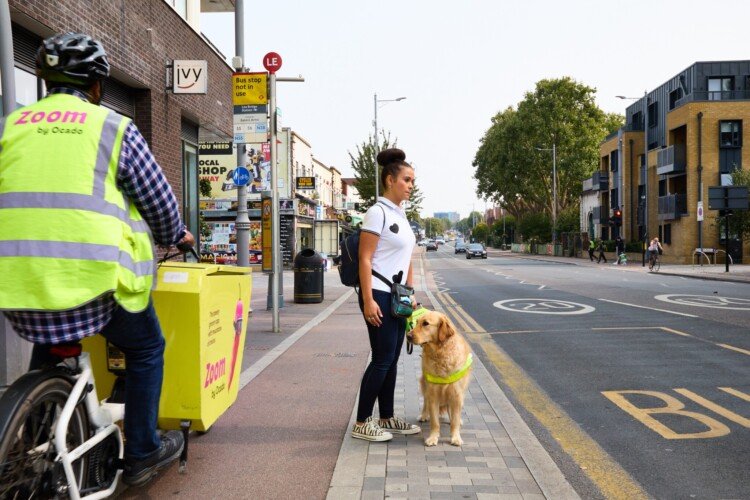‘Floating bus stops’ are a ‘menace’ for the blind, Bexley guide dog user says
A blind guide dog user has urged Sadiq Khan to pause and rethink the roll-out of ‘floating bus stops’ because of what she calls the dangers faced by the people like her, as well as the elderly and disabled.
Floating bus stops are found where a cycle lane cuts a bus stop from the rest of the pavement. They are intended to allow cyclists to keep moving, rather than being caught behind buses or forced to cycle out into busier lanes of traffic. Bus users are expected to cross the cycle lane to reach the pavement, usually via a ‘mini-zebra crossing’.
But its pitfalls are all too obvious for Taylor Notcutt, from Bexley, who has only 10 per cent vision and gets around with the help of her three-year-old Golden Retriever, Labrador cross called Jilly.
She has first-hand experience of a floating bus stop at Shooters Hill and says it is so fraught with danger, she sometimes gets off one stop earlier just to avoid it.
Taylor, 29, told the South London Press: “Bus travel is vital for the blind because we can’t cycle or drive and it is an integral part of our day-to-day routine. We need to have our voices heard over this.
“There’s a particularly bad one in Shooters Hill, where you come straight off the bus into a cycle lane. There isn’t even a small area of paving as you get off. Jilly has to get off ahead of me straight into the cycle lane – putting two paws on the floor before edging out.

“You feel under pressure because you don’t want to hold anyone up, but you need to be so careful.
“It’s a problem, even with a guide dog in other words, and if you are blind and using a walking stick, even more so. It can be dangerous for cyclists, too, with a potential for sticks getting caught up in spokes.”
Taylor says that if floating bus stops must exist, there needs to be a uniform design that the blind can work with, and clearly delineated paving bumps on the floor to differentiate pavements from cycle lanes.
She said: “It’s bad that we were not consulted over this and the designs do not seem safe. The scheme should be frozen until something safer is put in place.”
Her views have been echoed by the National Federation of the Blind of the UK, which has said the bus stops are “chaotic, confusing and dangerous places which are not safe or accessible for blind and visually impaired people to use independently”.
But the group – which has a petition supported by 290 organisations – goes further, calling for the roll out to halted completely and all existing floating bus stops to be scrapped.
Sarah Gayton, street access campaign coordinator, said: “Floating bus stops cannot be made safe and accessible for blind people. It’s not a case of trying to add on bits – the fundamental design does not work.”
Sadiq Khan has so far refused to bow to pressure to pause the roll-out of ‘floating bus stops’.

The London Mayor’s office says that “very few collisions” have occurred between cyclists and pedestrians at the stops, but added that City Hall is “actively working with disabled and accessibility groups to look at improvements to the design, as well as the behaviour of road users”.
But, the National Federation of the Blind of the UK dispute Transport for London’s (TfL) figures, which claim that only six incidents have been recorded in relation to the bus stops in the past three years.
Ms Gayton said: “I have filmed four cyclist or pedestrian collisions at floating bus stops this year alone. It is clear that there are many more collisions and injuries occurring that just aren’t being recorded.”
A TfL safety review, published in June, said: “The chance of being injured by someone cycling at a bus stop bypass is very low compared to the chance of being injured by a driver on the wider network”.
A spokesman for the Mayor said: “Protected cycle routes, which can feature bus stop bypasses on bus routes, reduce the risk of injury to cyclists by 40-65 per cent and are an important part of London’s Vision Zero goal to eliminate deaths and serious injuries on our roads.”
Pictured top: Taylor and Jilly at a ‘floating bus stop’ (Picture: Guide Dogs)
